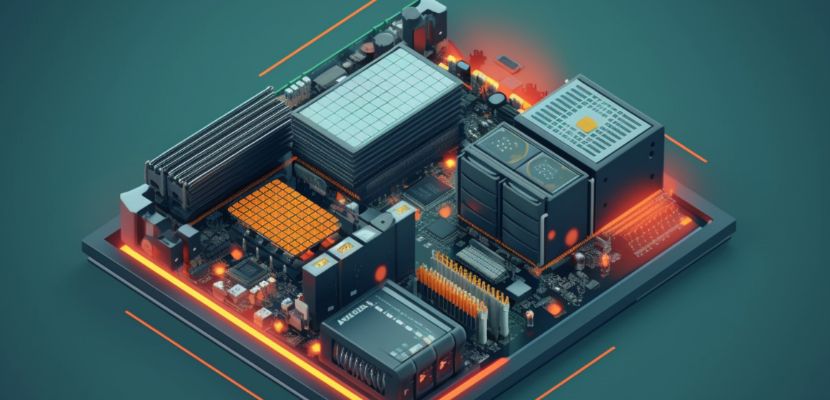Server workload refers to the total amount of computing tasks, processes, or applications running on a server at any given time. It reflects how much demand is placed on the server’s resources, including CPU, memory, storage, and network capacity.

What Is Server Workload?
Server workload represents the collective processing demand placed on a server by all running applications, services, and user activities. It encompasses the total volume and complexity of tasks the server handles, including transaction processing, data storage operations, network communication, virtualization, and other compute-intensive activities. Server workload directly impacts the consumption of critical system resources such as CPU cycles, memory, disk I/O, and network bandwidth.
Workloads can vary significantly based on the server’s role, such as web hosting, database management, file storage, or application delivery, and may fluctuate over time due to changes in user activity, scheduled processes, or unexpected traffic spikes.
Understanding and managing server workload is essential for maintaining system performance, preventing resource bottlenecks, and ensuring that the server operates within its designed capacity.
Types of Server Workload
Server workloads vary based on the tasks and services a system is expected to perform. Below are the most common types of server workloads:
- Transactional workloads. These workloads involve processing large volumes of small, discrete operations that require quick response times and high reliability. Common in financial systems, ecommerce platforms, and order processing environments, transactional workloads emphasize fast input/output (I/O) performance and low latency.
- Analytical workloads. Analytical workloads focus on processing large datasets to generate insights, perform queries, or support business intelligence. They often require significant CPU and memory resources for complex calculations, data aggregation, and report generation. Examples include data warehouses, analytics platforms, and big data processing.
- File and storage workloads. These workloads involve serving, storing, and managing large amounts of unstructured data such as documents, media files, or backups. File servers, storage arrays, and backup systems fall under this category, with performance depending heavily on disk I/O throughput and storage capacity.
- Web and application workloads. Web and application workloads involve hosting websites, APIs, or business applications accessed by users over a network. These workloads require a balance of CPU, memory, and network resources to handle dynamic content delivery, application logic processing, and user interactions.
- Virtualization and container workloads. In virtualized environments, a single server hosts multiple virtual machines (VMs) or containers, each running isolated applications or services. These workloads demand high CPU, memory, and I/O efficiency to support resource sharing while maintaining performance for individual instances.
- High-performance computing (HPC) workloads. HPC workloads involve intensive computations for scientific simulations, engineering modeling, or research tasks. These workloads require maximum CPU, GPU, and memory resources and are often run on clusters or specialized server hardware optimized for parallel processing.
- AI and machine learning workloads. These workloads involve training, deploying, or inferring models for artificial intelligence applications. They are typically compute- and GPU-intensive, requiring high throughput and fast memory access to support neural networks, deep learning, and data processing pipelines.
- Mixed workloads. Many modern servers run mixed workloads, combining different types, such as application hosting with background analytics or file services. Proper resource allocation and workload isolation are critical to prevent performance degradation in these environments.
Server Workload Key Characteristics

Each server workload has unique technical demands that influence how resources are allocated and managed. Understanding the key characteristics of a workload is essential for selecting the right infrastructure, ensuring performance stability, and optimizing system efficiency. Below are the primary characteristics that define server workloads:
- Resource intensity. Server workloads vary in how heavily they consume system resources such as CPU, memory, storage, and network bandwidth. Some workloads, like analytics or AI tasks, require high processing power, while others may be more storage- or network-dependent.
- Scalability requirements. Different workloads have distinct scalability demands. Web servers or cloud applications often require the ability to scale horizontally to handle more users or requests, while transactional or database workloads may need vertical scaling to enhance performance within a single server.
- Performance sensitivity. Many workloads are sensitive to latency, throughput, or response times. For example, transactional systems require low-latency processing, whereas backup workloads can tolerate higher delays but need large storage capacity.
- Workload variability. Workload demand can be steady or fluctuate based on time of day, user activity, or business cycles. Servers must handle predictable peaks or sudden spikes, making workload predictability an important factor in system design.
- Availability and uptime requirements. Critical workloads demand high availability and fault tolerance to ensure continuous operation. Examples include financial transactions, healthcare systems, or communications platforms where downtime is not tolerated.
- Security and compliance needs. Certain workloads involve processing sensitive data subject to regulatory requirements, such as healthcare or financial information. These workloads require enhanced security controls, encryption, and compliance with standards like GDPR, HIPAA, or PCI DSS.
- Isolation and multi-tenancy. In virtualized or containerized environments, workloads often share hardware while maintaining logical isolation. Ensuring resource separation and preventing workload interference is essential for performance stability and security.
- Data persistence and storage demands. Some workloads, such as file servers or databases, require persistent, reliable storage, while others, like stateless web applications, rely more on temporary memory and processing resources. Matching storage characteristics to workload needs is vital for system efficiency.
How Do I Know If My Server Is Overloaded?
You can identify if your server is overloaded by monitoring system performance indicators and looking for consistent signs of resource exhaustion. Common symptoms of an overloaded server include high CPU utilization (consistently above 80–90%), excessive memory usage leading to swapping or out-of-memory errors, disk I/O bottlenecks, and network congestion. Users may experience slow application response times, failed requests, or timeouts. Other indicators include increased server temperature, frequent service crashes, and delayed system processes.
Regular monitoring through server management tools, resource dashboards, and alerts can help detect overload conditions early and prevent performance degradation or downtime.
What Affects Server Workload?
Several factors influence server workload by determining how much demand is placed on system resources at any given time. The most common factors affecting server workload include:
- Application type and complexity. The nature of the applications running on the server, such as databases, websites, file storage, or AI models, directly impacts resource consumption. More complex or resource-intensive applications generate higher workloads.
- Number of concurrent users. An increase in active users or simultaneous connections raises CPU, memory, and network demands, especially for web servers, APIs, and transactional systems.
- Data volume and processing requirements. Large datasets, real-time analytics, or tasks involving heavy computations significantly increase workload intensity, requiring higher processing power and storage throughput.
- Peak usage times. Workload often spikes during specific hours, such as business hours or promotional events, causing temporary increases in system demand.
- Background processes and scheduled tasks. Regular maintenance tasks like backups, updates, or system scans can temporarily raise the workload, affecting performance for primary applications.
- Virtualization and resource sharing. In shared environments, multiple virtual machines or containers competing for the same physical resources amplify the overall server workload.
- Configuration and optimization. Poor system configurations, outdated software, or inefficient code can increase resource consumption, making workloads heavier than necessary.
- Security threats or malicious activity. DDoS attacks, unauthorized access attempts, or malware infections can artificially inflate server workload, consuming resources and degrading performance.
How to Measure Server Workload?
Measuring server workload involves monitoring key system performance metrics to assess how much demand is being placed on the server’s resources. Common methods include tracking CPU utilization, memory usage, disk I/O, and network traffic in real time. Tools such as system resource monitors, performance dashboards, and specialized server monitoring software provide visibility into workload trends and bottlenecks.
Metrics like average CPU load, memory availability, disk queue lengths, and network throughput help quantify the workload and identify resource saturation. In virtualized environments, it’s also important to monitor workload distribution across virtual machines or containers. Regular performance reports and threshold-based alerts allow administrators to detect when the workload approaches or exceeds acceptable limits, enabling proactive scaling, optimization, or troubleshooting.
How to Optimize Server Workload?

Optimizing server workload involves improving resource efficiency to maintain stable performance, reduce bottlenecks, and prevent overload. This can be achieved by balancing workloads across available resources, upgrading hardware where necessary, and fine-tuning system configurations. Techniques such as load balancing distribute incoming requests across multiple servers to prevent any single system from becoming a bottleneck.
Virtualization and containerization allow workloads to be isolated and scaled dynamically based on demand. Regularly optimizing applications, databases, and storage configurations reduces unnecessary resource consumption. Additionally, proactive monitoring helps identify underutilized or overburdened systems, enabling administrators to redistribute workloads, implement automation, or adjust resource allocation to align with real-time needs.
Why Is Server Workload Analysis Important?
Server workload analysis is essential for maintaining system performance, stability, and resource efficiency. By understanding how workloads impact CPU, memory, storage, and network utilization, organizations can prevent performance degradation, reduce downtime, and ensure optimal use of infrastructure.
Workload analysis helps identify bottlenecks, forecast capacity needs, and guide decisions on scaling, hardware upgrades, or system optimization. It also plays a critical role in cost management by revealing over-provisioned or underutilized resources. In virtualized and cloud environments, workload analysis ensures effective resource distribution and supports dynamic scaling strategies. Ultimately, it enables IT teams to align server performance with business demands, improve reliability, and extend the lifespan of hardware.
What Is the Difference Between Server Workload and Server Capacity?
Server workload refers to the actual amount of processing demand or tasks being executed on a server at a given time. It reflects real-time resource consumption, including CPU usage, memory utilization, disk I/O, and network traffic generated by applications, services, and users.
Server capacity, on the other hand, represents the maximum amount of workload a server can handle while maintaining stable and reliable performance. It defines the server’s physical and technical limits in terms of processing power, memory size, storage throughput, and network bandwidth.
In simple terms, workload is the current demand; capacity is the server’s ability to meet that demand. Monitoring both is essential to avoid exceeding capacity, which leads to performance issues, service disruptions, or system failures.